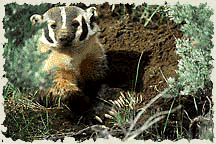Yellowstone is home to abundant and varied wildlife, unlike anywhere else in America. Nearly all of the wildlife species that inhabited the park when it was first explored over 100 years ago survive today. Early morning and evening hours are the best times to view wildlife.
Badgers, like the one pictured are common at lower elevations and can be spotted in the northern range of Yellowstone park. The badgers favorite food in Yellowstone are ground squirrels, and we often see badgers digging in the ground in search of a meal. Patience, and a lot of sitting and looking are the keys to spotting badgers.
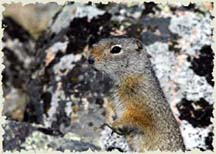
Uinta Ground Squirrel’s are a popular and favorite food item for many of Yellowstone’s predators including coyote’s, badgers, and hawks.
These small rodents can be found throughout the park, however they do hibernate during winter months.
An easy way to remember the name Uinta when you spot one is to say, “hey! what are you in ta?”
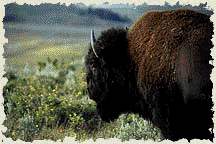
Bison are very unpredictable and one of the more dangerous animals in Yellowstone park. Visitors often crowd around or get too close to bison and some have been gored, injured or even killed over the years. Real examples of visitors getting too close to bison, and the results–View bison goring video’s.
Bison are common in Yellowstone park and can be viewed in many locations during most of the year. However, if you visit Yellowstone in August your best chance of viewing them will be at Hayden Valley. Bison travel from all over Yellowstone park in late July to Hayden Valley for their annual mating season. Plan on viewing them in early morning while they are located in Hayden Valley. During mid-day to early evening the traffic is terrible and you can expect to be caught in a 3 or 4 mile long traffic jam for sometimes hours. Avoid the Canyon area from noon till dusk in August or late July. Bison can also be viewed in the Lamar Valley each month of year.
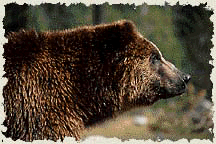
Grizzly bears are also considered dangerous, but few visitors in Yellowstone Park get the chance to view them today. For the most part, grizzly bears avoid the roads and heavy use areas that are occupied by people. Research has found that the average adult grizzly bear will avoid an active road up to 2.4 miles.
During spring and mid summer, a few visitors do get lucky and have the opportunity to see a grizzly bear. In early spring (May and June) bears can be viewed just about anywhere in the park. In late summer (Aug.) visitors report seeing grizzly bears at Canyon and Mount Washburn.
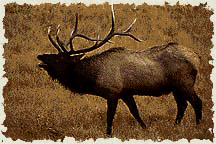
Elk are common throughout Yellowstone Park. During September, bull elk gather herds of cows for their annual mating season and the large bulls can be heard throughout the day bugling. Bull elk can be very dangerous during this period. Keep your distance.
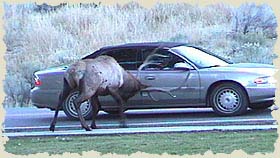
In the past, bull elk have sometimes charged and attacked cars or trucks who parked too close. A few Yellowstone visitors have even been gored or tossed into thermal waters by sex starved bull elk after they got too close.
The key areas during the Sept. rut to spot and photograph elk are: Norris Campground, Madison Campground, Mammoth Hotel, and for an especially nice surprise treat, drive and park up on Dunraven Pass in the late afternoon or early morning, above Antelope Creek. The distant sounds of many bull elk bugling is hard to describe, and worth every effort.
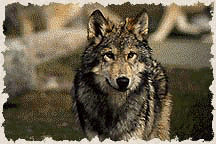
Wolves can be viewed in Yellowstone park today, but most visitors spot coyotes thinking they are viewing wolves. Winter is the best time for viewing wolves, and can be viewed from the northern boundary of Yellowstone park to as far south as Jackson, Wy. The most popular area to view wolves is in the northern range of Yellowstone between Mammoth and Cooke City, Mt.
Rocky Mountain Grey Wolves come in a wide variety of colors, from pure white, solid black, chocolate brown, to a modeled black and grey mix. All wolves in Yellowstone are especially large. (leave your cursor over the image of the wolf for a second example)
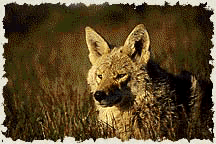
Coyotes are much more visible, and are often mistaken for wolves. Coyotes can be viewed at any time and in any location throughout Yellowstone Park. For more information regarding identification go to “wolves” page. (leave your cursor over the image of the coyote for a second example)
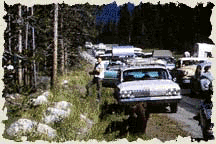
Black bears were once common along side roadways and in campgrounds in Yellowstone Park where visitors would feed them. Today, this practice is banned. It is unlawful to feed any animal in Yellowstone park, especially bears. Today, when a bear comes within view of the road, or campground park rangers will often show up to scare the bears away using “cracker shells”, or provide security by keeping visitors at a safe distance and prevent anyone from tossing food, or trying to get too close. Black bears are often viewed during the summer near Tower Falls, Old Faithful and at Canyon.

Pronghorn Antelope, the fastest land mammal in North America are commonly found near Mammoth and the north entrance into Yellowstone Park, along with any of the northern range in the park including the Lamar Valley during summer months. In winter, like most grass eaters in the park, the antelope migrate out of the park and onto ranch lands which are lower in elevation and have less snow. Gardiner Montana is the best location to view pronghorn during the winter and very early spring months. As the snow melts, pronghorn move farther east and into the Lamar Valley.

Bald eagles, are more commonly found during the winter months in Yellowstone park. The eagles migrate down from Canada and Alaska during the early winter and feed on animals that have died here in the park. They are also commonly found feeding on wolf kills during the winter months up in the northern range of the park. They then migrate back home in early spring where they feed on the spawning salmon.
Note: Starting in 1999 we have observed more bald eagles during the summer months in Yellowstone park. One pair in particular have nested and given birth along the Madison River between Madison Junction and the entrance at West Yellowstone Montana. Due to high traffic and stress levels, the park service has had to place no stopping, no walking, no parking regulations 50 yards on either side of this popular nest, along with a slower speed limit.
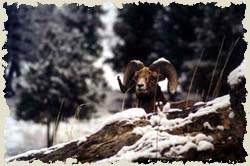
Big Horn Sheep are easily located up in the northern range of Yellowstone park, near Mammoth, the north entrance, the Lamar Valley, Mount Washburn, and outside Yellowstone park at Gardiner, Mt., Big Sky, and around Hebgen Lake near West Yellowstone, Montana. Winter is the best time of year to view Big Horn Sheep. As snow melts, the sheep move up in elevation for safety.

Moose are not very common in Yellowstone. On average we see maybe 3 or 4 moose a year in the park. Yellowstone is not prime habitat for moose, and is a bit too high in elevation. Grand Teton Park, south of Yellowstone is prime moose habitat and many moose are commonly viewed throughout that southern park, especially in the fall.
Moose are occasionally viewed north of West Yellowstone and south of Big Sky, Montana along the banks of the Gallatin River within Yellowstone Park. During winter, moose are sometimes observed out the northeast entrance at Cooke City, Montana, and up at Big Sky ski resort where new homeowners have planted aspen and willow.
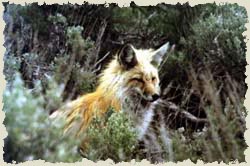
Red Fox can be found in any of the lower elevations of Yellowstone. The northern range of the park is especially good habitat for spotting fox. Very early morning and late evening hours are the most active times for fox.
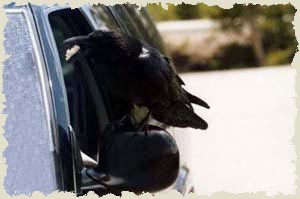
Ravens can be found in any location through Yellowstone Park. It is unlawful to feed any animal in Yellowstone, including birds. If you choose to feed an animal like the visitor in the vehicle pictured, you could receive a citation.
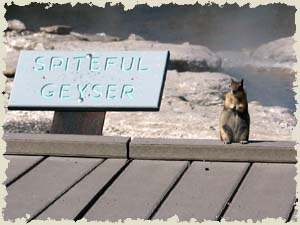
Ground squirrels are common throughout the park. Pictured is a golden manteled ground squirrel in the upper geyser basin, begging for food. Remember……..please don’t feed the wildlife. They will live longer without our “help”.
Extra’s
Be a responsible visitor and read over the Wildlife Viewing Etiquette page prior to your visit. Don’t get caught up in the group, or “herd” mentality.
To get a decent look at Yellowstone, try to plan on a four or five day visit, with at least one of those days dedicated to hiking. Less than 2% of visitors use the backcountry, which is where the real Yellowstone is found.
Check with a visitors center before hitting the trail, or at very least stop and read over the bulletin board found at every trailhead. Closure’s, recent dangers, etc…..will be posted here, along with comments left by previous hikers in the log book. Check the trail registry log book for any comments about bears, aggressive moose, or other dangers that hikers have experienced I recommend having a backup trail to hike, just in case.
Most importantly, remember that you are in a very special place. Slow down, take your time and “smell the roses”.
For Fun!
Stop somewhere during a hike and have everyone find a seat. Choose an amount of time, say…… 2 minutes and ask everyone to be as quiet as possible. Listen for the sounds of the forest. See how long it takes for the forest to return to life, with birds and small rodents reappearing first.
Just sitting for a few minutes like this will do more to recharge your batteries than just about anything else you could do. Soak it up, and the next time you find yourself wide awake and unable to sleep, just close your eyes and allow yourself to slip back to that spot.
If you have children, turn it into a game. Pass out small pieces of paper, and have everyone write down every sound they hear in one column and every living creature they spot in a second column. Compare notes after the time expires. How do the sights and sounds compare with where you live? Did anyone write down grass and trees as a living organism?
Submit your review | |

